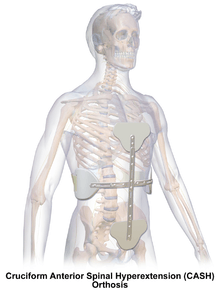Spinal fracture
| Spinal fracture | |
|---|---|
 | |
| Lateral spine X-ray showing osteoporotic wedge fractures of L1/2 | |
| Classification and external resources | |
| ICD-10 | S32.0-S32.1 |
| ICD-9-CM | 805 |
| eMedicine | article/248236 |
| MeSH | D016103 |

CASH Orthosis.
A spinal fracture, also called a vertebral fracture or a broken back, is a fracture affecting the vertebrae of the spinal column.
Types
- Cervical fracture
- Fracture of C1, including Jefferson fracture
- Fracture of C2, including Hangman's fracture
- Flexion teardrop fracture – a fracture of the anteroinferior aspect of a cervical vertebral
- Clay-shoveler fracture – fracture through the spinous process of a vertebra occurring at any of the lower cervical or upper thoracic vertebrae
- Burst fracture – in which a vertebra breaks from a high-energy axial load
- Compression fracture – a collapse of a vertebra, often in the form of wedge fractures due to larger compression anteriorly
- Chance fracture – compression injury to the anterior portion of a vertebral body with concomitant distraction injury to posterior elements
- Holdsworth fracture – an unstable fracture dislocation of the thoracolumbar junction of the spine
Vertebral fractures of the thoracic vertebrae, lumbar vertebrae or Sacrum are usually associated with major trauma and can cause spinal cord damage that results in neurological deficit.[1]
References
- ↑ Mirghasemi, Alireza; Mohamadi, Amin; Ara, Ali Majles; Gabaran, Narges Rahimi; Sadat, Mir Mostafa (November 2009). "Completely displaced S-1/S-2 growth plate fracture in an adolescent: case report and review of literature". Journal of Orthopaedic Trauma. 23 (10): 734–738. ISSN 1531-2291. PMID 19858983. doi:10.1097/BOT.0b013e3181a23d8b.
This article is issued from
Wikipedia.
The text is licensed under Creative Commons - Attribution - Sharealike.
Additional terms may apply for the media files.